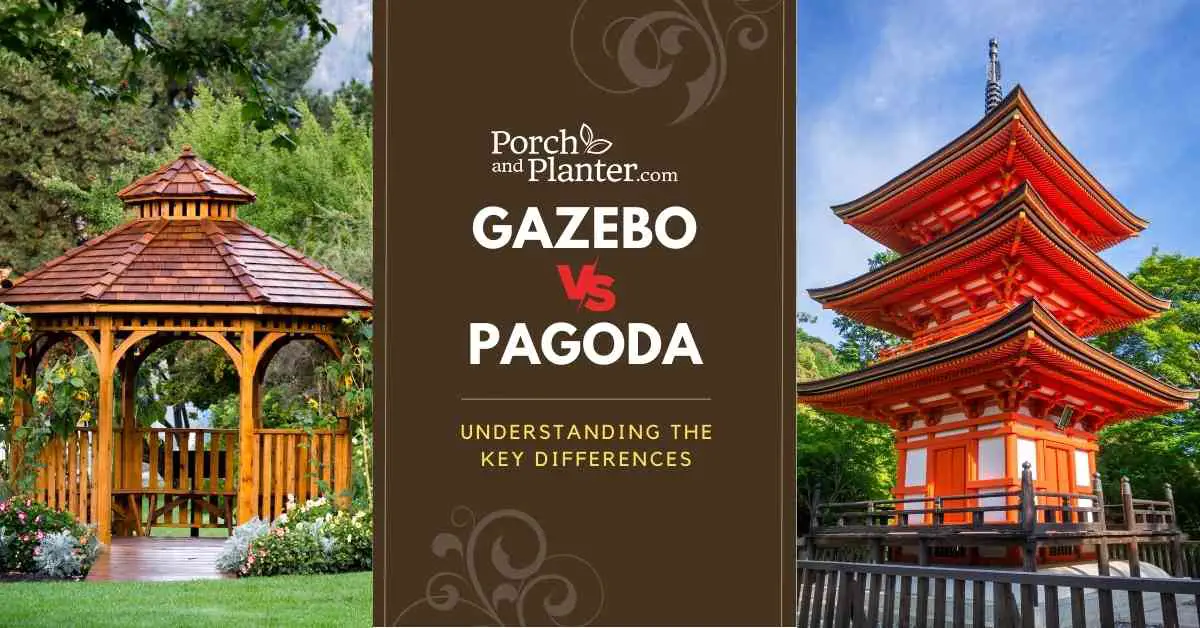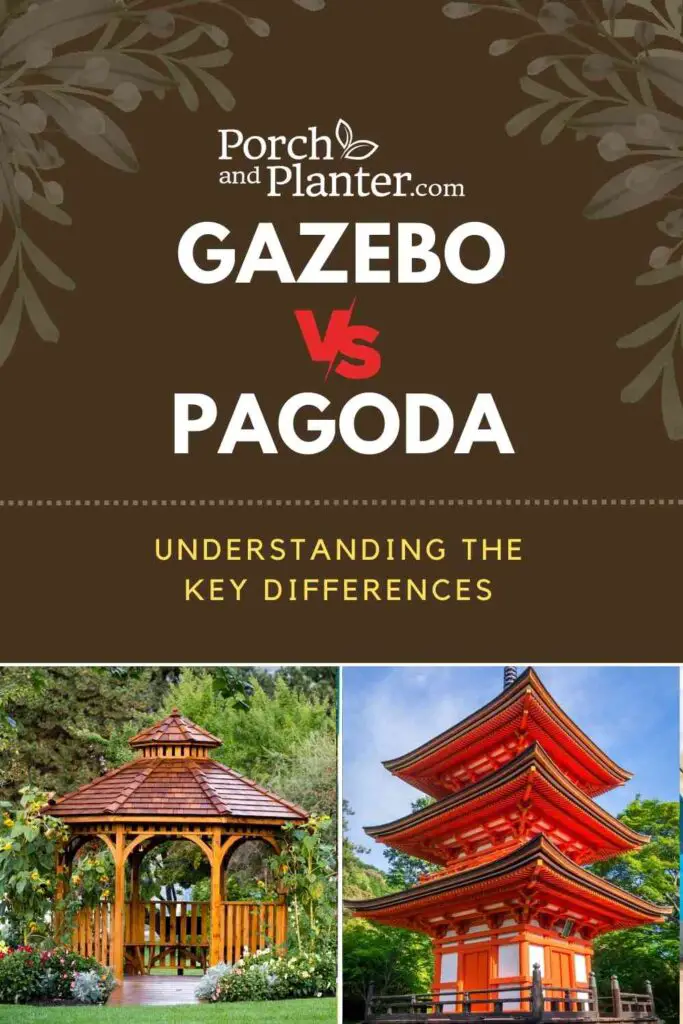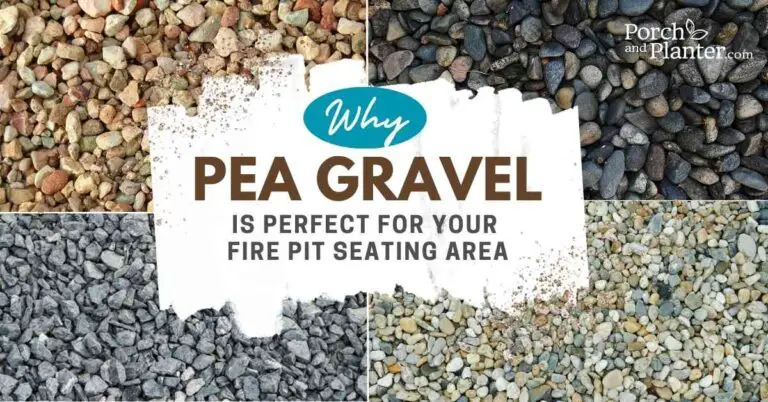Gazebo vs Pagoda: Understanding the Key Differences

Gazebos and pagodas are both popular outdoor structures that add charm and elegance to any garden or backyard. However, despite their similarities, there are some key differences between them that are worth noting. Understanding these differences can help you make an informed decision when choosing which one to add to your outdoor space.
Gazebo vs Pagoda
Gazebos and pagodas are not the same things. One of the most visible differences between gazebos and pagodas is their roof design. Gazebos typically have a peaked roof that is supported by four or more pillars, while pagodas have a multi-tiered roof that often features upturned eaves. Additionally, pagodas are usually enclosed structures, while gazebos are open on all sides.
Another difference between gazebos and pagodas is their cultural origins. Gazebos have been a staple in Western architecture for centuries, while pagodas have their roots in Eastern architecture. Pagodas are often associated with Buddhism and are commonly found in Japanese and Chinese gardens, while gazebos are more commonly found in European and North American gardens.
Definition of Gazebo and Pagoda
A gazebo is an outdoor structure that is typically round or octagonal in shape and has a roof supported by pillars or columns. It is often used as a place to relax or entertain guests and can be found in parks, gardens, and backyards. The roof of a gazebo can be open or closed, and it may have screens to keep out insects. Gazebos are usually one-story structures and are not typically used for religious or spiritual purposes.
A pagoda, on the other hand, is a multi-tiered tower that is typically found in East Asia. It is often used as a religious or spiritual structure and can be found in Buddhist, Taoist, and Shinto temples. Pagodas are usually made of wood or stone and have multiple roofs that curve upward at the corners. They are often decorated with intricate carvings and paintings and may have bells or other religious symbols hanging from their eaves.
While both gazebos and pagodas are outdoor structures, they serve very different purposes and have distinct architectural features. Gazebos are often used as places to relax or entertain, while pagodas are typically used for religious or spiritual purposes. Gazebos are usually one-story structures with a roof supported by pillars or columns, while pagodas are multi-tiered towers with multiple roofs that curve upward at the corners.
Design and Structure Differences
Roof Design
One of the most noticeable differences between a gazebo and a pagoda is the roof design. Gazebos usually have a peaked or domed roof, while pagodas have a tiered roof with multiple levels. The roof of a pagoda is typically more ornate and decorative than that of a gazebo. Gazebo roofs are often made of materials like shingles or thatch, while pagoda roofs are commonly made of tile or slate.
Pillars and Posts
Both gazebos and pagodas feature pillars or posts that support the roof. However, the design of these supports can differ. Gazebos typically have simple, straight pillars that support the roof. In contrast, pagodas often have more intricate and decorative posts, such as those with carvings or ornamental details. Pagoda posts may also be wider at the base and taper towards the top, while gazebo posts are typically straight and uniform in size.
Flooring
The flooring of a gazebo or pagoda can also differ. Gazebos are often built on a raised platform or deck, while pagodas may be built directly on the ground. Gazebo flooring can be made of materials like wood, concrete, or tile, while pagoda flooring is typically made of stone or brick.
Overall Shape
The overall shape of a gazebo and a pagoda can also differ. Gazebos are often round or octagonal in shape, while pagodas are typically square or rectangular. Pagodas may also have curved or sloping roofs, while gazebos have a more symmetrical roof design.
Materials Used
Wooden Gazebos
Wooden gazebos are a popular choice for those who want a natural and rustic look in their outdoor space. They can be made from a variety of wood types, including cedar, redwood, and pine. Cedar and redwood are both naturally resistant to decay and insects, making them a great choice for outdoor structures. Pine is a more affordable option, but it requires regular maintenance to keep it looking its best.
Metal Gazebos
Metal gazebos are a durable and long-lasting option. They can be made from aluminum, steel, or wrought iron. Aluminum is a lightweight and affordable option, but it may not be as sturdy as other metals. Steel is a heavier and stronger option, but it may be prone to rust if not properly maintained. Wrought iron is a classic and elegant option, but it can be expensive.
Stone and Concrete Gazebos
Stone and concrete gazebos are a permanent and sturdy option. They are typically made from materials such as limestone, granite, or concrete. Stone gazebos are a beautiful and natural option, but they can be expensive and require professional installation. Concrete gazebos are a more affordable option, but they may not have the same aesthetic appeal as stone.
Wooden Pagodas
Wooden pagodas are a traditional and elegant option. They can be made from a variety of wood types, including cedar, redwood, and teak. Cedar and redwood are both naturally resistant to decay and insects, making them a great choice for outdoor structures. Teak is a more expensive option, but it is known for its durability and resistance to weathering.
Function and Uses
Gazebo Uses
Gazebos are primarily used as outdoor entertainment areas or as a place to relax and enjoy the outdoors. They often have a permanent roof canopy that provides shade and shelter from the elements. Gazebos can be standalone structures or attached to a deck or patio. They are often used for outdoor dining, hosting parties, or as a quiet retreat for reading or enjoying nature. Gazebos can also be used as a focal point in a garden or as a shelter for a hot tub or outdoor spa. They can be designed in a variety of styles, from traditional to modern, and can be made from a range of materials, including wood, metal, and vinyl.
Pagoda Uses
Pagodas are also outdoor structures that are primarily used for shelter from the sun or rain. They typically feature a roof supported by pillars or columns and can be found in a variety of sizes and styles. Pagodas are often used as a decorative element in a garden or as a focal point in an outdoor space. Pagodas can also be used as a place for meditation or relaxation. They are often designed with intricate details and can be made from a range of materials, including wood, stone, and metal. Pagodas can be standalone structures or incorporated into a larger garden design. In summary, gazebos are primarily used for outdoor entertainment and relaxation, while pagodas are often used as a decorative element and a place for meditation or relaxation. Both structures provide shelter from the elements and can be designed in a variety of styles to suit different outdoor spaces.
Cost and Maintenance
Gazebo Cost and Maintenance
Gazebos are generally less expensive than pagodas, with prices ranging from a few hundred dollars to several thousand dollars, depending on the size, material, and design. Wooden gazebos are the most common, but they require regular maintenance, such as staining or painting, to prevent rot and weather damage. Metal and vinyl gazebos are more durable and require less maintenance, but they may be more expensive. In terms of upkeep, gazebos require regular cleaning to remove debris and prevent mold and mildew growth. They may also need to be re-stained or re-painted every few years to maintain their appearance and protect them from the elements.
Pagoda Cost and Maintenance
Pagodas are generally more expensive than gazebos due to their larger size, multiple floors, and more intricate design. Prices can range from several thousand dollars to tens of thousands of dollars, depending on the material and design. In terms of maintenance, pagodas require regular cleaning to remove debris and prevent mold and mildew growth. They may also need to be re-sealed or re-painted every few years to maintain their appearance and protect them from the elements. Due to their larger size and multiple floors, pagodas may require more extensive repairs if they become damaged.
Overall, both gazebos and pagodas require regular maintenance to ensure their longevity and appearance. While gazebos may be less expensive and easier to maintain, pagodas offer a more unique and impressive design for those who are willing to invest in the cost and upkeep.
Conclusion
Both gazebos and pagodas are beautiful garden structures that can add value and functionality to your outdoor space. When deciding between a gazebo and a pagoda, it’s important to consider your specific needs and preferences. If you’re looking for a larger structure that can accommodate a large number of guests, a gazebo may be the best option. However, if you’re looking for a real statement piece and have the financial means and space to put in a large structure, a pagoda might be something to consider. Ultimately, the decision between a gazebo and a pagoda comes down to personal preference and the specific needs of your outdoor space. No matter which structure you choose, you’re sure to enjoy the beauty and functionality that it brings to your garden or backyard.




![Do Patios Need Drainage? [ANSWERED]](https://porchandplanter.com/wp-content/uploads/2021/09/do-patios-need-drainage-768x402.jpg)


